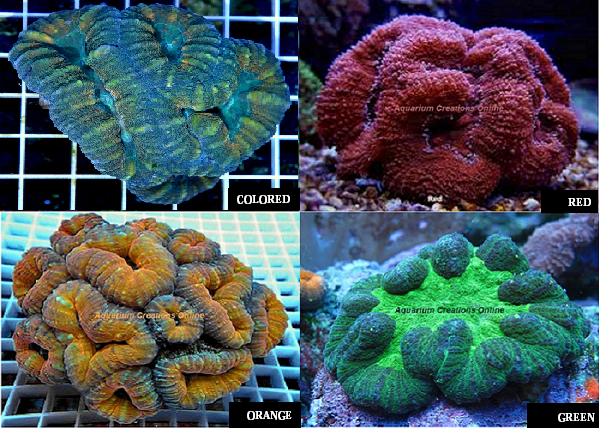The Ultra Australia Lobophyllia Brain Corals are colorful large polyp stony (LPS) corals, hardy and disease free and commonly available. It is also a very good coral for those fairly new to reef keeping, as its care requirements are quite simple, as it should be placed where water movement is slow to moderate, and with moderate lighting. It has fleshy polyps that hide their calcareous skeleton. It goes by many names, including Meat Coral, Wrinkle Coral, Lobed Brain Coral, Brain Coral, Open Brain Coral, Flat Brain Coral, Red Brain Coral, Modern Coral, Large Flower Coral. Found in many different textures from carpet like, bumpy, and even smooth. With colors including orange, red, green, grey, tan, purple, yellow, blue and brown, everyone a beautiful coral and no 2 are alike! In the wild colonies of Lobophyllia Brain Coral can grow to a height of six feet or more.
The Lobophyllia species originates from the Indo-Pacific and the South Pacific regions including Tonga, Fiji, Philippines, Solomon Islands the Great Barrier Reef, the Red Sea and Southern Japan.
Difficulty Moderately easy to care for. Being moderately easy to care for, they only need a lower moderate light and gentle water movement. The green variety handles moderate lighting better. The most important care that must be exercised for a long lasting and healthy coral is daily feeding. They are voracious eaters, and if not fed well can start to recede. The polyps tentacles come out at night to feed, and may come out during the day when food is present. Colonies are flat to hemispherical and may include colonies having different colors and polyp mantles of different texture. Specimens are sometimes found with two or more colors, where valley wall coloration differ from the central mouth area.
Aggressiveness Lobophyllia Brain Coral is semi-aggressive towards other marine aquarium corals. Therefore leave plenty of space between it and other corals so they cannot be stung. We recommend a minimum of 6" around the coral.
Water-flow
The Open Brain Coral requires a moderate water flow
Lighting
Since the Lobophyllia Brain Coral is found in shallow water regions on the slopes of upper reef and on lagoons it requires moderate lighting (from PAR 150-250). T5's, Metal Halides, or LED's can all grow Trachyphyllia geoffroyi corals when the proper PAR levels are provided. We recommend a 14-20K color spectrum for best coloration. If it will be exposed to brighter lighting it needs to be acclimated to the high lights in the tank slowly, as it is not usually exposed to intense lighting in the ocean because of its depth. Start out with low lighting, positioning the polyps to face out (versus upwards) and have it shaded by rock or something within the tank. The lighting can gradually get stronger over time, but make the changes very slowly.
Tank Recommendations
A mature, well-fed live rock/reef environment is what is needed for your Lobo Brain Coral, along with some fish for organic matter production, and dissolved organics. Care must be taken when placing the coral in the aquarium so that nothing will damage its soft tissue. When placing in the aquarium place them on the substrate or mid-way in the aquarium where they will receive the most direct light. All Brain corals including the Lobophyllia can become shocked and potentially bleached (a rapid die-off of the algae in its tissue) after rapid changes in the intensity of its lighting. Always acclimate carefully, over many weeks time if you are increasing the light intensity. Have an area of substrate that is free from rocks or other sharp objects to put your lobophyllia coral on. Placing it in rock work can cause the flesh to be cut, leading to disease and death.
Diet and Feeding
In captivity, the Open Brain Coral can be fed at night when the feeding tentacles are out, but they will come out during the day as well, if it senses food in the water. Feed it daily. They will eat mysis, fortified brine shrimp, rotifers, Cyclopeeze and other similarly sized meaty foods. Larger pieces than a typical mysis is not digestible, and although the animal "accepts" it, it will regurgitate it up later in the night. The most important care that must be exercised for a long lasting and healthy coral is daily feeding. They are voracious eaters, and if not fed well can start to recede. The polyps tentacles come out at night to feed, and may come out during the day when food is present.
|



